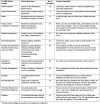Increasing specialty care access through use of an innovative home telehealth-based spinal cord injury disease management protocol (SCI DMP)
- PMID: 24617497
- PMCID: PMC4725789
- DOI: 10.1179/2045772314Y.0000000202
Increasing specialty care access through use of an innovative home telehealth-based spinal cord injury disease management protocol (SCI DMP)
Abstract
Background: A spinal cord injury disease management protocol (SCI DMP) was developed to address the unique medical, physical, functional, and psychosocial needs of those living with spinal cord injuries and disorders (SCI/D). The SCI DMP was piloted to evaluate DMP clinical content and to identify issues for broader implementation across the Veterans Affairs (VA) SCI System of Care.
Methods: Thirty-three patients with SCI/D from four VA SCI centers participated in a 6-month pilot. Patients received customized SCI DMP questions through a data messaging device (DMD). Nurse home telehealth care coordinators (HTCC) monitored responses and addressed clinical alerts daily. One site administered the Duke Severity of Illness (DUSOI) Checklist and Short Form-8 (SF-8™) to evaluate the changes in comorbidity severity and health-related quality of life while on the SCI DMP.
Results: Patients remained enrolled an average of 116 days, with a mean response rate of 56%. The average distance between patient's home and their VA SCI center was 59 miles. Feedback on SCI DMP content and the DMD included requests for additional clinical topics, changes in administration frequency, and adapting the DMD for functional impairments. Improvement in clinical outcomes was seen in a subset of patients enrolled on the SCI DMP.
Conclusion: SCI HTCCs and patients reported that the program was most beneficial for newly injured patients recently discharged from acute rehabilitation that live far from specialty SCI care facilities. SCI DMP content changes and broader implementation strategies are currently being evaluated based on lessons learned from the pilot.
Keywords: Home telehealth; Nursing; Spinal cord injury.
Figures





Comment in
-
Making the right connections with telehealth.J Spinal Cord Med. 2016;39(1):13-4. doi: 10.1080/10790268.2015.1116727. J Spinal Cord Med. 2016. PMID: 26796046 Free PMC article. No abstract available.
References
-
- CCHT Vendor Data Cube. VHA Support Service Center Proclarity Database [Intranet]. [Cited 2013 Mar 18]. Available from: http://vaww.vssc.med.va.gov.
-
- LaFramboise LM, Todero CM, Zimmerman L, Agrawal S. Comparison of health buddy™ with traditional approaches to heart failure management. Fam Community Health 2003;26(4):275–88. - PubMed
-
- Jia H, Chuang H, Wu SS, Wang X, Chumbler NR. Long-term effect of home telehealth services on preventable hospitalization use. J Rehabil Res Dev 2009;46(5):557–66. - PubMed
-
- Darkins A, Ryan P, Kobb R, Foster L, Edmonson E, Wakefield B, et al. . Care coordination/home telehealth: the systematic implementation of health informatics, home telehealth and disease management to support the care of veteran patients with chronic conditions. Telemed J E Health 2008;14(10):1118–26. - PubMed
-
- National Center for Veterans Analysis and Statistics [Internet]. Department of Veterans Affairs. [Cited 2013 Mar 26.] Available from: http://www.va.gov/vetdata
Publication types
MeSH terms
LinkOut - more resources
Full Text Sources
Other Literature Sources
Medical
